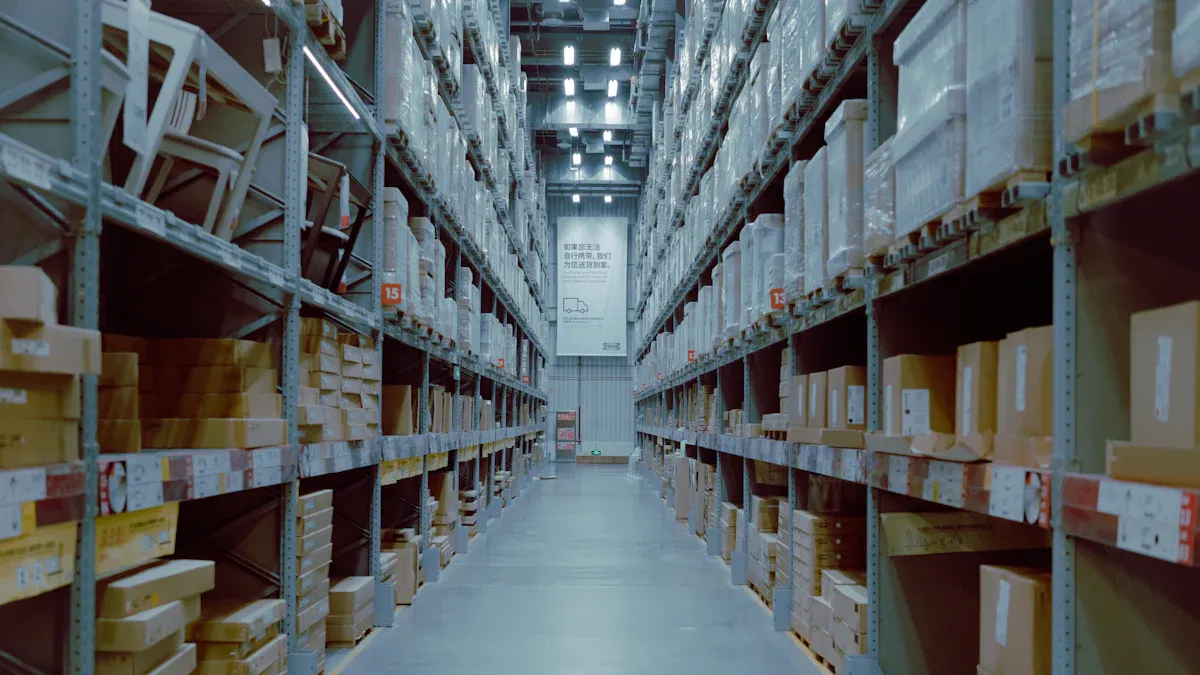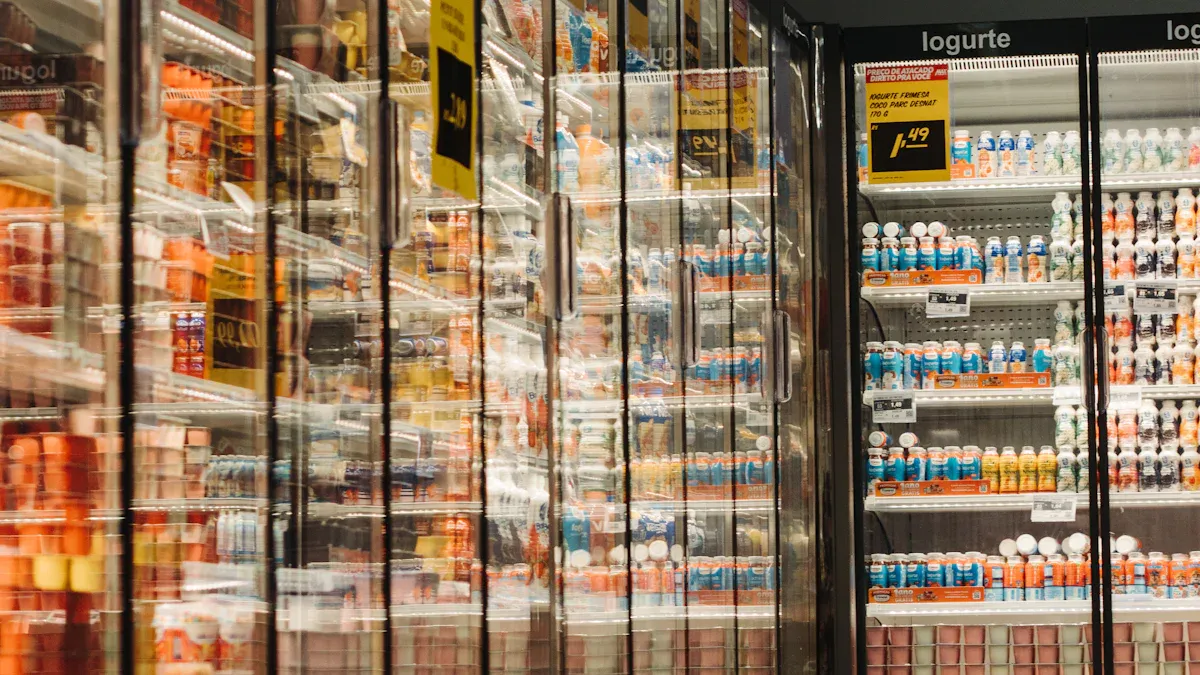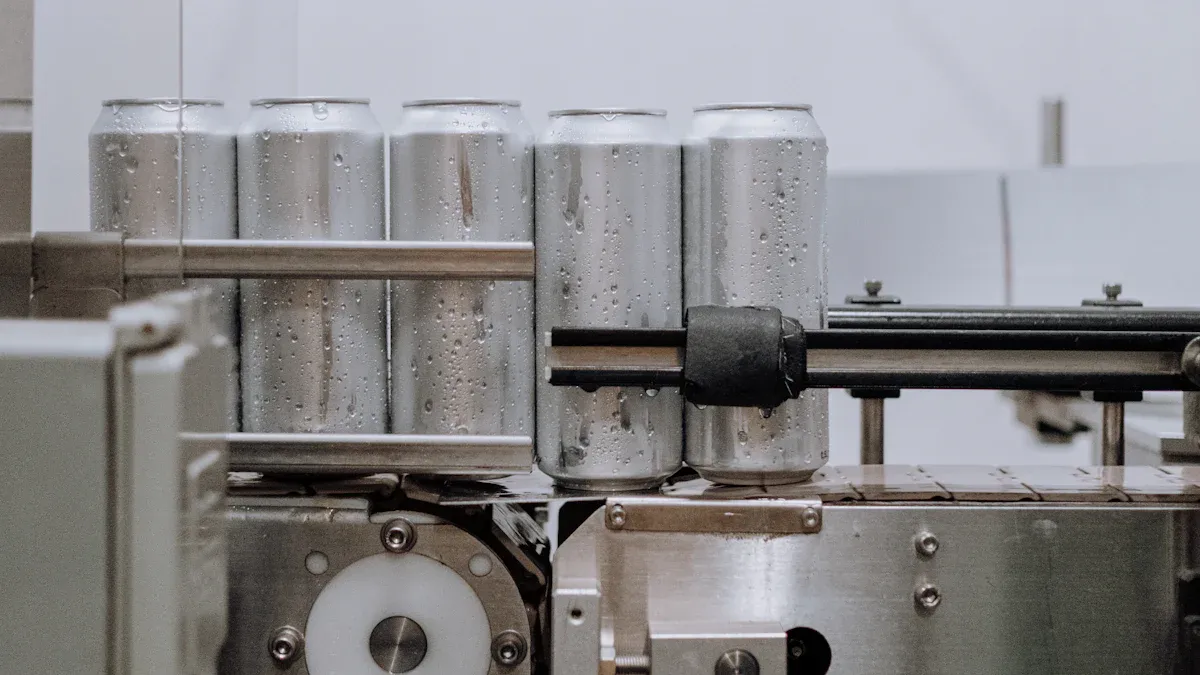Understanding the Uses of Walk-In Cold Storage Systems

A walk-in cold storage system, or walk-in cooler, is a big, closed space that stays cold. These systems store items like food, medicine, or flowers. They keep things fresh by slowing down how fast they spoil. Walk-in coolers are important for industries needing to protect temperature-sensitive items. Cold storage helps keep goods safe and high-quality. For businesses, this reduces waste and makes customers happier. In some places, people call these systems Walk-in cold storage.
Key Takeaways
Walk-in coolers keep food and items fresh by staying cold. This stops food from going bad and reduces waste.
Energy-saving designs in walk-in coolers cut costs and help nature. Checking insulation and seals often can save more energy.
Businesses can customize walk-in coolers to fit their needs. This helps store food, medicine, or flowers the best way.
Smart temperature controls let you check the cooler in real-time. This keeps items safe and at the right temperature.
Taking care of walk-in coolers is very important. Fixing seals, insulation, and settings keeps them working well.
What Is a Walk-In Cold Storage System?
Definition and Purpose
Walk-in coolers are large storage spaces that stay cold. They are used to keep perishable items fresh and safe. Industries like food, healthcare, and farming rely on them. These coolers store fruits, vegetables, medicines, and flowers. They follow health rules, especially for food and medicine safety. Insulation, fans, and cooling systems work together to save energy. In some areas, people call them Walk-in cold storage.
Key Features of Walk-In Coolers
Walk-in coolers have special features for business needs. Cooling systems keep temperatures steady to protect stored goods. They are energy-saving, which lowers costs and helps the planet. Fans spread cold air evenly to stop spoilage. Tools like thermostats and monitors control the temperature exactly. These features make them great for storing sensitive items.
Importance for Temperature-Sensitive Goods
Some items need the right temperature to stay good. Dairy, seafood, vaccines, and produce can spoil fast. Walk-in coolers create a safe, cold space for these goods. They slow down spoiling, saving money and reducing waste. These systems also meet safety rules to protect people’s health. Whether for a restaurant, pharmacy, or farm, they are very useful.
Key Components of Walk-In Cold Storage Systems

Insulation and Its Role
Insulation is very important in walk-in coolers. It keeps the inside temperature steady by blocking heat from outside. This helps stored items stay fresh and safe. Thick insulation, like 4-inch foamed-in-place urethane, works best. It keeps temperatures stable even in tough weather. Seamless designs stop moisture from getting in, which protects perishable goods.
Insulation Type | Benefits |
|---|---|
4-inch thick foamed-in-place urethane | Keeps temperatures steady and saves energy. |
Seamless construction | Blocks moisture to protect stored items. |
Modern insulation materials, like those in Polar King models, save energy while keeping cooling steady. These features make insulation a key part of good refrigeration systems.
Refrigeration Units and Cooling Mechanisms
Refrigeration units are the main part of walk-in coolers. They remove heat to keep the storage area cold. Energy-efficient systems use less power but still work well. This lowers costs and helps the environment.
Model | Energy Efficiency Features | Operational Performance | Space Optimization |
|---|---|---|---|
Polar King H1416 | Uses less energy, keeps temperatures steady | Works well even with high demand | Adjustable storage options |
Polar King H812 | Saves energy, cost-effective | Keeps a stable environment | Small size, holds a lot |
These systems spread cold air evenly to avoid warm spots. This ensures all items stay at the right temperature. Picking the right system saves energy and protects your goods.
Temperature Control Systems
Temperature control is crucial for walk-in coolers. Advanced systems let you check and adjust the temperature easily. Thermostats control the cooling system to keep the set temperature. Digital tools show real-time data on temperature and humidity. This helps you fix problems quickly.
Component | Function |
|---|---|
Thermostats | Controls cooling to keep the set temperature. |
Digital Monitoring | Shows real-time temperature and humidity data. |
Consistent Temperature | Keeps items fresh and stops spoilage. |
These systems keep goods in the best condition. They are especially useful for food and healthcare industries, where small temperature changes can ruin items.
Doors, Seals, and Shelving Configurations
Doors, seals, and shelves are key for cold storage systems. The door stops cold air from escaping. Insulated doors keep the temperature steady. These doors have high R-values, meaning better insulation. Higher R-values save energy and control temperature well. You can pick hinged, sliding, or roll-up doors. Each type helps reduce temperature changes in different ways.
Seals stop cold air from leaking out. Good seals, like magnetic strips or gaskets, close tightly. This saves energy and keeps the cooler stable. Without strong seals, even insulated doors won’t work well.
Shelves inside help organize and use space better. Adjustable shelves fit items of different sizes. They also allow air to flow around stored goods. Wire shelves are common because they improve airflow and stop cold spots.
Tip: Check doors and seals often for damage. Fixing seals can save energy.
Focusing on these parts improves your cold storage system. It keeps goods fresh and lowers costs.
How Walk-In Cold Storage Systems Work
Keeping the Right Temperatures
Walk-in coolers keep temperatures steady to protect perishable goods. They create a safe space for items like dairy and vaccines. Advanced controls help keep the temperature within the right range. Real-time tools let you see changes in temperature quickly. If the temperature shifts, alerts tell you to act fast. This stops spoilage and keeps stored items safe.
How Insulation and Refrigeration Work Together
Insulation and refrigeration keep walk-in coolers cold and efficient. Insulation blocks outside heat from entering the cooler. Strong materials, like foamed-in-place urethane, save energy by helping the cooling system work less. Refrigeration units remove heat from inside the cooler. Modern systems, like Arctic Active Cooling units, are reliable and energy-saving. They also keep humidity levels just right for sensitive goods. Together, insulation and refrigeration make cold storage work well and use less energy.
Saving Energy and Helping the Planet
Modern walk-in coolers are built to save energy. They use smart designs to lower electricity costs and help the environment. Energy-efficient refrigeration systems reduce power use and bills. Alerts and monitoring tools help find and fix energy waste. Sustainable designs also keep products fresh, which is great for businesses. These systems help lower your carbon footprint while protecting stored goods.
Tip: Check insulation and refrigeration often to save energy and make your cooler last longer.
Practical Applications of Walk-In Cold Storage Systems

Food Service and Hospitality
Cold storage is crucial for keeping food fresh. Restaurants and hotels use it to store meat, dairy, and vegetables safely. These systems stop food from spoiling or getting contaminated. You can adjust the storage size to fit your needs. This makes organizing and finding ingredients much easier.
Big operations like banquet halls also need cold storage. They use it to keep large amounts of food and drinks fresh. Energy-saving systems help lower costs while keeping quality high.
Healthcare and Pharmaceuticals
Healthcare needs cold storage for medicines and vaccines. Hospitals use these systems to keep supplies safe and effective. Walk-in coolers can hold large amounts of temperature-sensitive items.
Pharmaceutical companies use special designs for their storage needs. For example, mortuaries use walk-in refrigerators to store bodies respectfully. Funeral homes rely on these systems to preserve remains safely. These examples show why temperature control is so important in healthcare.
Logistics and Supply Chain Management
Cold storage helps deliver fresh goods in perfect condition. It provides a stable space for items during shipping. Large storage units make handling big shipments easier.
You can adjust storage spaces for different items, like fruits or frozen foods. Reliable cooling systems protect goods throughout the supply chain. Advanced cold storage improves efficiency and reduces waste in logistics.
Note: Check your cold storage often to keep it working well and save energy.
Agriculture and Farming
Walk-in cold storage systems are very helpful for farming. They keep harvested crops fresh and reduce waste. Farmers store fruits, vegetables, and dairy at the best temperatures. This stops spoilage and makes produce last longer. With the right conditions, farmers can deliver fresh goods to buyers.
Cold storage is also useful for seasonal farming. Extra crops can be stored during harvest and sold later. This increases profits and lowers losses. For example, apples, potatoes, and onions stay fresh for months in cold storage. Shelves in these systems help organize crops neatly. This makes it easy to find and manage items.
Tip: Check temperature and humidity often to keep crops fresh.
Specialty Applications (e.g., floristry, breweries, walk-in body refrigerators)
Walk-in cold storage systems are used in many industries. Florists use them to keep flowers fresh and colorful. By controlling temperature and humidity, flowers last longer and don’t wilt. Breweries also need cold storage to protect beer quality. Cooling keeps the beer’s flavor and texture just right.
Another use is for walk-in body refrigerators. Funeral homes use them to respectfully preserve human remains. These systems keep a low temperature to slow decomposition. Hospitals and labs also use them for medical and research needs. They ensure sensitive materials stay safe with steady cooling.
Note: Pick a walk-in body refrigerator that meets safety rules.
Benefits of Walk-In Cold Storage Systems
Better Product Quality and Longer Shelf Life
Walk-in coolers help keep products fresh and safe. They slow down spoiling by keeping the right temperature. Fruits stay crisp, and dairy stays safe to eat. These systems also keep food healthy and full of nutrients. Customers get better-quality items because of this.
Cold storage lets you store items longer without wasting them. This saves money and reduces losses for businesses. Whether you run a restaurant, pharmacy, or farm, it’s very helpful.
Tip: Check the temperature often to keep items in good condition.
Following Industry Rules
Walk-in coolers help businesses follow important safety rules. Food laws require storing items at certain temperatures. These systems make it easy to meet those rules and avoid fines.
In healthcare, they keep medicines and vaccines working properly. By controlling the temperature, you meet health standards and protect people. Farmers also use them to store crops that meet market quality.
Note: Always check temperature tools to follow safety rules.
Saving Money and Being Flexible
Cold storage systems save money for businesses. Newer models use less energy, lowering electricity costs. They also cut waste by keeping items fresh for longer.
Energy-saving systems are good for the environment.
Efficient designs lower energy use and save money.
Advanced features keep products fresh and reduce expenses.
Walk-in coolers can be customized for different needs. They work for food, flowers, or medicine storage. Their flexibility makes them a smart choice for all businesses.
Tip: Pick a cooler with energy-saving options to save more money.
Customization for Specific Needs
Walk-in cold storage systems can be adjusted to fit your needs. Whether you own a restaurant, pharmacy, or flower shop, these systems can be designed to match your business. This makes sure your storage works well for your products.
You can pick different sizes, from small units to big ones. Shelves can be changed to fit items of various shapes. Wire shelves help air move, while solid shelves hold heavy things. You can also choose doors, like sliding ones for tight spots or roll-up ones for quick use.
Temperature settings can also be customized. You can set exact temperatures for items like vaccines, seafood, or flowers. Advanced tools let you check and change conditions anytime. This is very important for healthcare, where walk-in body refrigerators must stay at steady temperatures to keep remains safe.
Special designs are made for certain industries. Breweries can get systems to store beer just right. Florists can add humidity controls to keep flowers fresh. Funeral homes need walk-in body refrigerators with specific features to meet safety rules. These custom options make sure your storage fits your needs.
Tip: Work with experts to create a system that fits your needs. This helps save money and improves efficiency.
Customizing walk-in cold storage systems makes them useful and flexible. By designing them to fit your needs, you can save money, reduce waste, and protect your goods.
Walk-in cold storage systems are important for keeping items safe. They create the best conditions for goods that spoil easily. This helps reduce waste and keeps things fresh longer. Many industries, like healthcare, food service, and medicine, rely on them.
Modern cooling systems let you control temperatures exactly. Tools like alerts and monitors make them safer to use. Whether you run a restaurant, pharmacy, or farm, these coolers are dependable. Using them protects your products, saves money, and follows rules.
Tip: Take care of your system often to keep it working well.
FAQ
What is the best temperature for walk-in coolers?
The right temperature depends on what you store. Food needs 32°F to 40°F. Frozen items need below 0°F. Use digital tools to check and change settings easily.
How often should seals and insulation be checked?
Check seals and insulation every month. Look for cracks or gaps. Fix broken seals quickly to save energy and keep items fresh.
Can small businesses use custom walk-in coolers?
Yes, small businesses can get custom coolers. Pick small sizes, adjustable shelves, and specific temperature settings. They work well for small restaurants, pharmacies, or flower shops.
How can you save energy with walk-in coolers?
Keep doors shut as much as you can. Check insulation often. Use energy-saving cooling systems and watch temperature settings. These tips lower costs and improve efficiency.
Are walk-in coolers safe for storing medicine?
Yes, they are safe for medicines like vaccines. They meet healthcare rules for temperature-sensitive items. Use advanced tools to keep cooling steady and protect medicines.
See Also
Understanding Cold Storage Systems And Their Importance
Comparing Container Cold Rooms And Conventional Storage Solutions
Choosing The Ideal Walk-in Cold Room For Your Needs
Solving Storage Challenges With Versatile Cold Storage Solutions
Revolutionizing Goods Storage Through Innovative Cold Room Solutions

